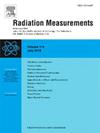基于放大成像的能量选择性伽马射线成像系统探测效率目标优化
IF 2.2
3区 物理与天体物理
Q2 NUCLEAR SCIENCE & TECHNOLOGY
引用次数: 0
摘要
在惯性约束聚变(ICF)的研究中,4.44 MeV伽马射线的能量选择成像对于评估烧烧炉的体积和对称性至关重要。然而,现有的能量选择性伽马射线成像系统存在探测效率低的问题。本文提出了一种用于能量选择性伽马射线成像的目标优化探测系统,通过优化转换目标和电子收集角来匹配目标探测效率,从而提高探测效率。此外,为了保持空间分辨率,采用了放大成像技术,以尽量减少高阶像差。利用蒙特卡罗方法对整个系统进行了仿真,结果表明,该系统对4.44 MeV的伽马射线能量的探测效率为9.4 × 10−4,能量分辨率为0.54 MeV。该系统在60 × 60 mm2的视野范围内,水平(x)方向的空间分辨率约为1mm,垂直(y)方向的空间分辨率约为2.5 mm。基于放大成像的能量选择性伽马射线成像系统目标优化方法进一步证明了能量选择性伽马射线成像技术在ICF实验中的应用前景。本文章由计算机程序翻译,如有差异,请以英文原文为准。
Detection efficiency goal optimization of energy-selective gamma-ray imaging system by magnification imaging
In the study of Inertial Confinement Fusion (ICF), energy-selective imaging of 4.44 MeV gamma rays is critical for assessing the volume and symmetry of the ablator. However, existing energy-selective gamma-ray imaging systems suffer from low detection efficiency. This paper proposes a goal optimized detection system for energy-selective gamma-ray imaging, which improves detection efficiency by optimizing the conversion target and electron collection angle to match the target detection efficiency. Additionally, to preserve spatial resolution, a magnification imaging technique is employed to minimize high-order aberrations. Simulation of the entire system using Monte Carlo methods demonstrates that the system achieves a detection efficiency of 9.4 × 10−4 and an energy resolution of 0.54 MeV for 4.44 MeV gamma-ray energy. The system exhibits a spatial resolution of around 1 mm in the horizontal (x) direction and 2.5 mm in the vertical (y) direction across a 60 × 60 mm2 field of view. The goal optimization method of energy-selective gamma-ray imaging system based on magnification imaging further proves the application prospect of energy-selective gamma-ray imaging technology in ICF experiment.
求助全文
通过发布文献求助,成功后即可免费获取论文全文。
去求助
来源期刊

Radiation Measurements
工程技术-核科学技术
CiteScore
4.10
自引率
20.00%
发文量
116
审稿时长
48 days
期刊介绍:
The journal seeks to publish papers that present advances in the following areas: spontaneous and stimulated luminescence (including scintillating materials, thermoluminescence, and optically stimulated luminescence); electron spin resonance of natural and synthetic materials; the physics, design and performance of radiation measurements (including computational modelling such as electronic transport simulations); the novel basic aspects of radiation measurement in medical physics. Studies of energy-transfer phenomena, track physics and microdosimetry are also of interest to the journal.
Applications relevant to the journal, particularly where they present novel detection techniques, novel analytical approaches or novel materials, include: personal dosimetry (including dosimetric quantities, active/electronic and passive monitoring techniques for photon, neutron and charged-particle exposures); environmental dosimetry (including methodological advances and predictive models related to radon, but generally excluding local survey results of radon where the main aim is to establish the radiation risk to populations); cosmic and high-energy radiation measurements (including dosimetry, space radiation effects, and single event upsets); dosimetry-based archaeological and Quaternary dating; dosimetry-based approaches to thermochronometry; accident and retrospective dosimetry (including activation detectors), and dosimetry and measurements related to medical applications.
 求助内容:
求助内容: 应助结果提醒方式:
应助结果提醒方式:


